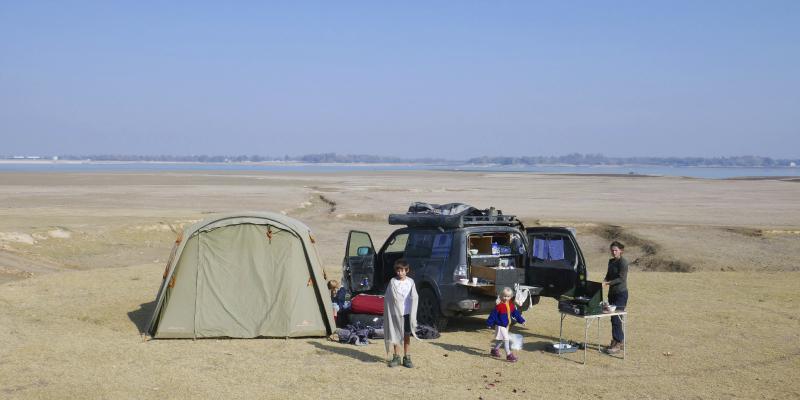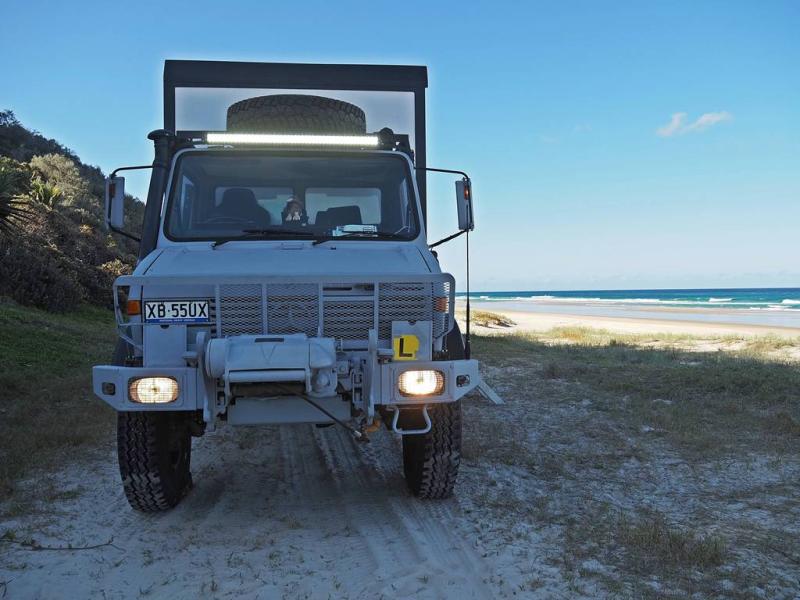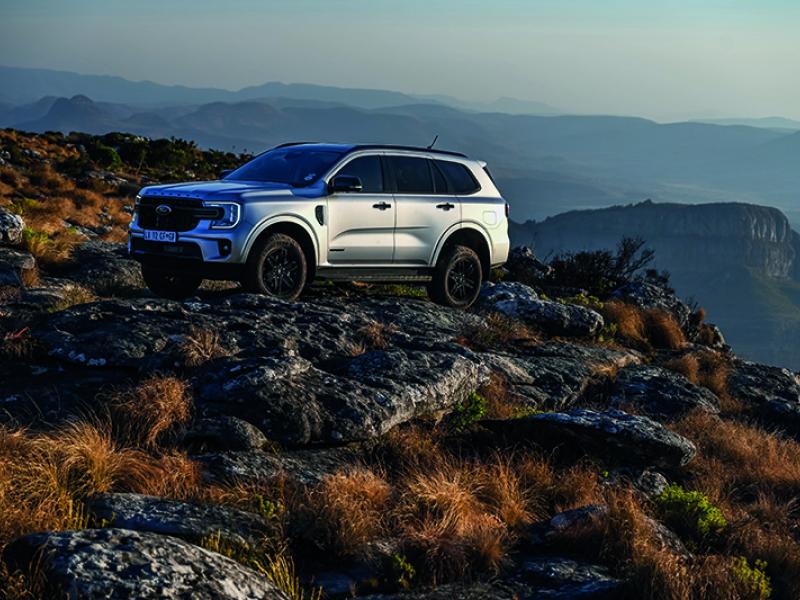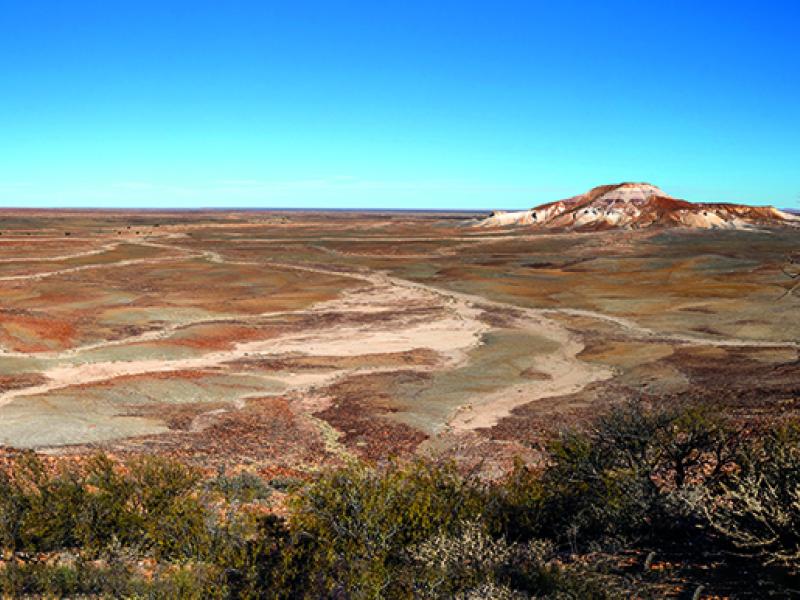On their way southwest from Tashkent, Kiwi Overlander Aaron Rich and family marveled at the unique Islamic architecture to be found in the ancient Silk Road cities of Samarkand and Bukhara.
We’d had a marvellous time exploring Tashkent, but it was time to move on. Seriously, it really was time to move on!
Our departure from Tashkent on the 14th of November 2019 was about six weeks behind my original plan, even if that was never set in stone. It’s worth briefly mentioning that one of the things we love most about this style of independent overland travel is precisely that nothing is set in stone. We don’t know much in advance where we’ll spend most nights.
Whilst we stay in apartments, hostels or guesthouses when exploring cities, the vast expanse of unoccupied land across Central Asia means that stopping just about anywhere along our routes to set up an impromptu camp for the night is not only possible, but usually essential. There’s no such thing as a commercial campground out here, rather it’s just a short departure from the road into the surrounding desert and home for the night is established with a few minutes work.
The reason we were running so far behind my initial itinerary was mainly due to our spending an extra month in Mongolia earlier in the trip. We explored more there than was originally planned, and also had some downtime in Ulaanbaatar awaiting a replacement suspension spring to be shipped from Australia.
Moreover, every country has taken a bit more time than was originally envisaged, as we discovered fascinating areas that I’d not been aware of at the planning stage. Ultimately, the ability to flex our itinerary at will has been crucial.
We headed out from Tashkent with as much diesel as we could carry; 170 litres in the Pajero’s two on-board fuel tanks, and a further 16 litres in containers to operate the tent heater. Earlier in the trip not even a jersey was needed in the warm evenings, and the tent heater had remained near permanently up on the roof rack.
But those summer days of Central Asia were by now long gone and as we ventured across Uzbekistan we were forced to abruptly transition from the seemingly never-ending autumn we’d enjoyed, straight into winter.
With almost all vehicles in Uzbekistan running on locally abundant gas (propane), I was fully aware that diesel (same applies to petrol) would be difficult to find once out of Tashkent. Thus, we set off into Uzbekistan’s more remote regions not knowing with any certainty if, when, or where we would next find diesel. The second fuel tank fitted to the Pajero is an essential asset in these circumstances.
While it didn’t give us enough fuel capacity to make it right through Uzbekistan to the Caspian Sea, where diesel was again plentiful, at least I knew it would serve as a crucial reserve to permit our return to Tashkent in a worst case scenario.
This so long as I kept a careful eye on our fuel usage and stayed on top of what I call my ‘point of no return’ estimation – it should be obvious what I mean by this. In fact, nowhere else where we’ve explored had it ever been necessary for me to manage our fuel capacity and touring range this closely; not even in the parts we’ve previously explored of Morocco’s Sahara Desert, nor Mongolia’s Gobi Desert.
So any readers planning on coming this way in future be warned.
Samarkand
The ‘Registan’, which has the meaning of ‘sandy place’ or ‘desert’ in Persian, was at the heart of the ancient city of Samarkand. In times long since gone by, local people gathered at this grand public square to hear royal proclamations... and to attend public executions.
Samarkand is one of the oldest continually inhabited cities of Central Asia. It is at least 2,500 years old, with some theories suggesting it was founded between the 8th and 7th centuries B.C. Given its location on the Silk Road between China and the Mediterranean, Samarkand was ideally positioned to prosper. Over the centuries it has been ruled by Persians, Greeks, Turks, Mongols, Chinese and Russians and at various times has been one of the greatest cities of Central Asia.
As for the Samarkand that exists today, as you’ll see it in my photos here, it was the infamous Turco-Mongol conqueror Timur who was chiefly responsible for its construction. Although the three grand madrasahs (Islamic schools) that surround the Registan were built after his death (1405), Timur’s brutal military conquests essentially laid Samarkand’s foundations. His wars were waged far and wide and are estimated to have resulted in the deaths of 17 million people (five percent of the world’s population at the time!).
Timur not only brought back the riches from his conquests abroad, but he also brought back the best artisans capable of building the most impressive monuments. Whereas residents of the cities his armies captured were most commonly massacred, Timur ordered his generals to spare the finest artisans and deport them back to Samarkand, where he could put them to work. Timur declared Samarkand his capital and desired to build it into the grandest of cities, even personally overseeing construction at times.
Two things stand out for me: (1) the incredible amount of human history to this part of the world; and (2) just how barbaric much of this history was, with repeated invasions and wars waged. While some invaders were intent on destruction, Timur – though equally brutal – desired to construct his perfect capital city, and ultimately he did.
The first of the three grand madrasahs that surround the impressive Registan was built by Timur’s grandson, about a decade after Timur’s death in the early 15th century. The other two were constructed in the 17th century. Today this site is doubtlessly one of the most impressive in what is today Uzbekistan, and moreover in my view is one of the highlights of a trip to Central Asia.
By the late 19th century this site had fallen into disrepair. First the Soviets and more latterly the Uzbeks have worked hard to restore the site to its former glory. It’s very impressive indeed to wander here, camera in hand, marvelling up close at the thousands of glazed mosaics that adorn these impressive structures.
Bukhara
Consider this: In 1839 Britain sent Colonel Charles Stoddart to reassure the Emir of Bukhara over Britain’s invasion of Afghanistan. But it would seem the British failed to appreciate just what a megalomaniac Emir Nasrullah Khan actually was – for reference, among his many brutal acts he seized the throne in Bukhara by killing all of his brothers and 28 relatives!
Colonel Stoddart broke local custom and caused offence by (1) riding up on his horse rather than walking up, (2) he brought no gifts, and (3) the official letter he delivered to the Emir was not from the Queen herself, but rather penned by the governor-general of India. The insulted Emir ordered that Stoddart be jailed and thrown into what was known as the ‘bug pit’, a truly awful dungeon filled with spiders, scorpions and rodents.
Two years later, in 1841, Britain sent Captain Arthur Conolly to attempt to negotiate Stoddart’s release. But Conolly too suffered the same fate and soon joined Stoddart in the ‘bug pit’. The Emir wrote to Queen Victoria, but is said to have received no reply, and thus he ordered the executions of both Stoddart and Conolly.
On 24 June 1842 both men were marched from their dungeon cells before a large crowd gathered before the ‘Ark’ – seen in one of my photos. They dug their own graves to the sound of drums and reed pipes and were beheaded. Back in England, furious friends and families of the murdered men raised enough funds to privately send their own emissary to Bukhara to confirm the news.
It’s beyond me who would agree to take on this third mission, however a clergyman named Joseph Wolf agreed to do so. It is believed that Wolf escaped a similar fate to that of Stoddart and Conolly only because the Emir thought he looked hilarious dressed in his clerical outfit.
Much of the history to this part of the world is rather brutal, right through to the relatively recent account just above. Brutal or otherwise, the history here is rich and deep; the human history to this part of the world spans not just centuries, but millennia! Fortunately, the Bukhara that exists today is another wonderful and visually rich site to safely wander around, in amazement at the ancient madrasahs, mosques and mausoleums.
Coming up Next!
In the next instalment we venture out into Uzbekistan’s deserts in search of what remains of ancient fortresses built out there as much as 2,500 years ago! My research led me to form a list of GPS coordinates, and what we found at some of those isolated desert sites was simply fascinating. I’ll have some extraordinary images to share when I return with my next article.






